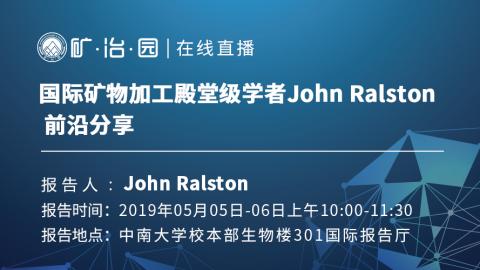

主讲人:John Ralston
报告时间:2019年5月5日-6日上午10:00-11:30
报告地点:中南大学校本部生物楼301国际报告厅
报告主题:
“Structured Interfaces, Interfacial Fluid Flow and Why Things Get Wet” and the second techniques for exploring interfaces:“Selected Advanced Analytical Techniques for Minerals Research [in and exsitu]: Snapshots”
报告人简介
John Ralston/University of South Australia Adelaide AUSTRALIA John is a Physical and Colloid Chemist with complementary training in metallurgy, University of South Australia, Adelaide, Australia, whose research interests embrace various aspects of interfacial science and engineering. His secondary education commenced at Christ Church Grammar in Melbourne and continued at Melbourne High School.John obtained his BSc[Hons] in Physical Chemistry at the University of Melbourne, subsequently completing his PhD in interfacial science under the supervision of Professor T W Healy.Since 1984,John has been awarded over $ 200M in competitive grant funding from the Australian Research Council, the Department of Education, Science and Training
and national and international private industry. John has received numerous awards and honours over the years. These include the Chemeca Medal in 2006 [Australia's highest honour in Chemical Engineering], the ATSE Clunies Ross Lifetime Contribution Award in 2009 and the Staudinger Durrer Lecture and Medal in 2012 from the Swiss Federal Institute of Technology, ETH Zurich, for influential contributions to the fields of colloid and surface science. In 2008 John was made an Officer of the Order of Australia. In 2007 John was awarded South Australian of the Year, the first scientist to be so honoured, as well as South Australian Scientist of the Year. Apart from mentoring research teams at UniSA, a number of his present activities, as a "roving ambassador" for UniSA, include strong interactions with universities, companies and research institutes internationally.
报告一
报告题目:Structured Interfaces, Interfacial Fluid Flow and Why Things Get Wet
报告时间:2019年5月5日上午10:00-11:30
报告摘要:
Wetting and interface science influence the success of many natural and industrial processes that rely on the wetting or non-wetting of surfaces.
Wetting and fluid flow are also central to understanding and controlling the behavior of small quantities of liquids on solid surfaces and through narrow channels. The structure, both chemical and topographical, of the interfaces involved and the manner in which a solid surface interacts with a liquid are crucial to manipulating the processes involved.
It is essential to identify how energy is dissipated when a liquid moves over a solid surface and what sort of interfacial liquid structure may exist, for the latter impinges upon slip length.X-ray reflectivity studies of solid liquid interfaces reveal that liquids are structured in a different manner from the bulk liquid, over just a few molecular layers, yet this persistent structure can have a profound influence upon interfacial properties. When a liquid flows over a surface or through a narrow channel, energy may be dissipated at the three phase contact line, by a thermally activated, interfacial rate process or in the bulk liquid. Which mode dominates depends on the fluid flow rates, the strength of the solid-liquid interactions, along with the structure and topography of the surface.
The exciting science underlying these different phenomena is discussed, accompanied by diverse applications, including mineral processing.
报告二
报告题目:Selected Advanced Analytical Techniques for Minerals Research [in and ex situ]: Snapshots
报告时间:2019年5月6日上午10:00-11:30
报告摘要:
The characterization of mineral surfaces in and ex-situ is critically important in all aspects of mineral processing and hydrometallurgy. Methods range from the determination of contact angle [advancing and receding], the measurement of turbulent dissipation energy and fluid velocity, bubble motion and interactions to understanding how a liquid interface advances or retreats over a surface.
Advanced surface analysis techniques such as XPS, Tof-SIMS, FTIR, PEEM and AFM, including those that are synchrotron based, enable nanoscale characterisation with chemical information for real mineral samples, either freshly fractured or exposed to simulated process conditions.
The combination of contact angle measurements, fluid dynamics, bubble motion and high resolution spatial imaging with photoemission spectra and X-ray absorption spectra, enables the direct study of particle surfaces and an understanding of how interactions take place in complex systems. This information permits well informed strategies to be developed for the processing of composite/heterogeneous samples.